What's inside
What's inside
 Key Ingredients
Key Ingredients

 Benefits
Benefits

 Concerns
Concerns

 Ingredients Side-by-side
Ingredients Side-by-side

Water
Skin ConditioningIsododecane
EmollientButylene Glycol
HumectantPolypropylene
Dimethicone
EmollientBis-PEG-18 Methyl Ether Dimethyl Silane
EmollientGlycerin
HumectantAmmonium Acryloyldimethyltaurate/Vp Copolymer
Polygonum Cuspidatum Root Extract
AntioxidantCucumis Sativus Fruit Extract
EmollientLaminaria Saccharina Extract
Skin ProtectingHordeum Vulgare Extract
EmollientSaccharomyces Lysate Extract
HumectantLactobacillus Ferment
Skin ConditioningChamomilla Recutita Extract
Skin ConditioningHelianthus Annuus Seedcake
AbrasiveCaffeine
Skin ConditioningSodium Hyaluronate
HumectantTrehalose
HumectantOleth-10
EmulsifyingCaprylyl Glycol
EmollientPolysilicone-11
Tocopheryl Acetate
AntioxidantPropylene Glycol Dicaprate
EmollientHexylene Glycol
EmulsifyingLaureth-23
CleansingTromethamine
BufferingLaureth-4
EmulsifyingAcrylates/C10-30 Alkyl Acrylate Crosspolymer
Emulsion StabilisingSilica
AbrasiveDisodium EDTA
Phenoxyethanol
PreservativeCI 15985
Cosmetic ColorantCI 14700
Cosmetic ColorantCI 19140
Cosmetic ColorantWater, Isododecane, Butylene Glycol, Polypropylene, Dimethicone, Bis-PEG-18 Methyl Ether Dimethyl Silane, Glycerin, Ammonium Acryloyldimethyltaurate/Vp Copolymer, Polygonum Cuspidatum Root Extract, Cucumis Sativus Fruit Extract, Laminaria Saccharina Extract, Hordeum Vulgare Extract, Saccharomyces Lysate Extract, Lactobacillus Ferment, Chamomilla Recutita Extract, Helianthus Annuus Seedcake, Caffeine, Sodium Hyaluronate, Trehalose, Oleth-10, Caprylyl Glycol, Polysilicone-11, Tocopheryl Acetate, Propylene Glycol Dicaprate, Hexylene Glycol, Laureth-23, Tromethamine, Laureth-4, Acrylates/C10-30 Alkyl Acrylate Crosspolymer, Silica, Disodium EDTA, Phenoxyethanol, CI 15985, CI 14700, CI 19140
Water
Skin ConditioningCyclohexasiloxane
EmollientAlcohol Denat.
AntimicrobialGlycerin
HumectantPropanediol
SolventDimethicone
EmollientZea Mays Germ Oil
EmollientPanthenol
Skin ConditioningAscorbyl Glucoside
AntioxidantTriethanolamine
BufferingPhenoxyethanol
PreservativeGlyceryl Linoleate
EmollientPolyperfluoromethylisopropyl Ether
Skin ConditioningPolyacrylamide
Dimethiconol
EmollientGlyceryl Oleate
EmollientCarbomer
Emulsion StabilisingCetyl Alcohol
EmollientC13-14 Isoparaffin
EmollientParfum
MaskingAcrylates/C10-30 Alkyl Acrylate Crosspolymer
Emulsion StabilisingGlycine Soja Oil
EmollientCaffeine
Skin ConditioningTocopherol
AntioxidantHydrogenated Lecithin
EmulsifyingCastanea Sativa Seed Extract
Skin ConditioningBenzophenone-4
UV AbsorberMenthol
MaskingLimonene
PerfumingPEG-100 Stearate
Glyceryl Stearate
EmollientPentylene Glycol
Skin ConditioningLaureth-7
EmulsifyingHydrolyzed Soy Protein
HumectantPotassium Cetyl Phosphate
EmulsifyingDisodium EDTA
Glyceryl Linolenate
EmollientCitrus Aurantium Dulcis Juice
Skin ConditioningCitrus Limon Juice
Skin ConditioningLinalool
PerfumingEthylhexylglycerin
Skin ConditioningSodium Benzoate
MaskingCitral
PerfumingPotassium Sorbate
PreservativeCI 42090
Cosmetic ColorantCI 14700
Cosmetic ColorantWater, Cyclohexasiloxane, Alcohol Denat., Glycerin, Propanediol, Dimethicone, Zea Mays Germ Oil, Panthenol, Ascorbyl Glucoside, Triethanolamine, Phenoxyethanol, Glyceryl Linoleate, Polyperfluoromethylisopropyl Ether, Polyacrylamide, Dimethiconol, Glyceryl Oleate, Carbomer, Cetyl Alcohol, C13-14 Isoparaffin, Parfum, Acrylates/C10-30 Alkyl Acrylate Crosspolymer, Glycine Soja Oil, Caffeine, Tocopherol, Hydrogenated Lecithin, Castanea Sativa Seed Extract, Benzophenone-4, Menthol, Limonene, PEG-100 Stearate, Glyceryl Stearate, Pentylene Glycol, Laureth-7, Hydrolyzed Soy Protein, Potassium Cetyl Phosphate, Disodium EDTA, Glyceryl Linolenate, Citrus Aurantium Dulcis Juice, Citrus Limon Juice, Linalool, Ethylhexylglycerin, Sodium Benzoate, Citral, Potassium Sorbate, CI 42090, CI 14700
Ingredients Explained
These ingredients are found in both products.
Ingredients higher up in an ingredient list are typically present in a larger amount.
Acrylates/C10-30 Alkyl Acrylate Crosspolymer is a synthetic polymer. It is used to thicken and improve the texture of products. Due to its properties, it can prevent water and oil ingredients from separating.
Caffeine is most associated with coffee, tea, and cacao. In skincare, it helps with calming inflammation and is rich in antioxidants.
While caffeine is used to treat cellulite and and dark circles, further studies are needed to prove this. It has been believed to help with these skin conditions due to its ability to dilate blood vessels and increase blood flow.
Some studies are looking into caffeine's ability to protect against UV rays.
Learn more about CaffeineCi 14700, also known as Red No. 4, is a synthetic red dye derived from petroleum. It is water soluble.
Dimethicone is a type of synthetic silicone created from natural materials such as quartz.
What it does:
Dimethicone comes in different viscosities:
Depending on the viscosity, dimethicone has different properties.
Ingredients lists don't always show which type is used, so we recommend reaching out to the brand if you have questions about the viscosity.
This ingredient is unlikely to cause irritation because it does not get absorbed into skin. However, people with silicone allergies should be careful about using this ingredient.
Note: Dimethicone may contribute to pilling. This is because it is not oil or water soluble, so pilling may occur when layered with products. When mixed with heavy oils in a formula, the outcome is also quite greasy.
Learn more about DimethiconeDisodium EDTA plays a role in making products more stable by aiding other preservatives.
It is a chelating agent, meaning it neutralizes metal ions that may be found in a product.
Disodium EDTA is a salt of edetic acid and is found to be safe in cosmetic ingredients.
Learn more about Disodium EDTAGlycerin is already naturally found in your skin. It helps moisturize and protect your skin.
A study from 2016 found glycerin to be more effective as a humectant than AHAs and hyaluronic acid.
As a humectant, it helps the skin stay hydrated by pulling moisture to your skin. The low molecular weight of glycerin allows it to pull moisture into the deeper layers of your skin.
Hydrated skin improves your skin barrier; Your skin barrier helps protect against irritants and bacteria.
Glycerin has also been found to have antimicrobial and antiviral properties. Due to these properties, glycerin is often used in wound and burn treatments.
In cosmetics, glycerin is usually derived from plants such as soybean or palm. However, it can also be sourced from animals, such as tallow or animal fat.
This ingredient is organic, colorless, odorless, and non-toxic.
Glycerin is the name for this ingredient in American English. British English uses Glycerol/Glycerine.
Learn more about GlycerinPhenoxyethanol is a preservative that has germicide, antimicrobial, and aromatic properties. Studies show that phenoxyethanol can prevent microbial growth. By itself, it has a scent that is similar to that of a rose.
It's often used in formulations along with Caprylyl Glycol to preserve the shelf life of products.
Water. It's the most common cosmetic ingredient of all. You'll usually see it at the top of ingredient lists, meaning that it makes up the largest part of the product.
So why is it so popular? Water most often acts as a solvent - this means that it helps dissolve other ingredients into the formulation.
You'll also recognize water as that liquid we all need to stay alive. If you see this, drink a glass of water. Stay hydrated!
Learn more about Water